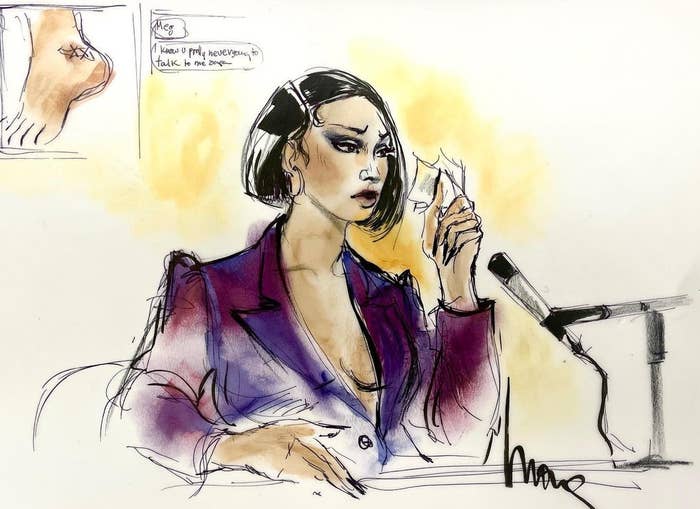
The trial of the State of California vs. Daystar Peterson, publicly known by his stage name Tory Lanez, was undoubtedly the most talked about celebrity case in hip-hop in 2022. The trial was in relation to a 2020 incident in which Lanez allegedly shot rapper Megan Thee Stallion several times, resulting in injuries to both of her feet following a heated altercation in Los Angeles. The incident became a media obsession as soon as the news broke, with celebrities and fans taking sides.
The trial began on Dec. 13, 2022, and lasted over a week, with Tory Lanez ultimately being found guilty of all charges. There was limited court access, with no cameras allowed inside the courtroom—a rule that forced outsiders to rely heavily on daily recaps and Twitter threads from reporters. Meghann Cuniff, a reporter based in Southern California, was praised for her accurate accounts of the trial amid misinformation that was pushed by hip-hop blogs. Cuniff wasn’t the only MVP of the trial, though.
Mona Shafer Edwards is a renowned courtroom illustrator who has covered some of the most high profile celebrity cases in history. In recent years, her portrayal of artists like the Kardashian family and Vanessa Bryant have gone viral on social media, providing another layer of detail and emotion to cases that have otherwise been closed to the public. Her recent work in the Megan and Tory trial provided audiences with a glimpse of the raw and emotional moments that took place over that week.
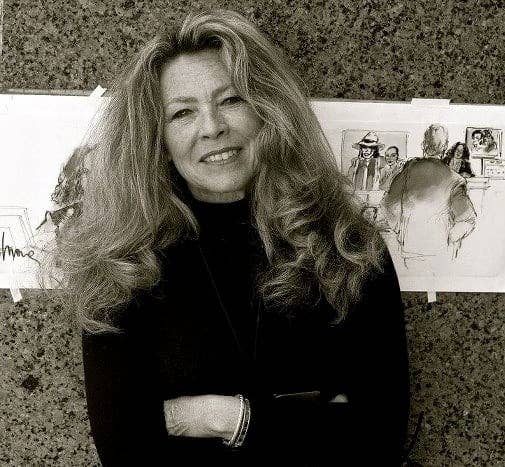
Edwards began her career as a fashion illustrator after attending the ArtCenter College of Design. One day, she noticed some poorly constructed drawings of a court case, and told her husband, “I could do much better than that.” After some encouragement on his end, she began calling various news stations to inquire about illustrator gigs. It took some persuading, but eventually she convinced the art director at NBC to give her a chance. Her first case was the landmark Lee Marvin palimony case of 1977, in which Michella Triola unsuccessfully sued actor Lee Marvin for financial support; the two cohabitated as partners from 1965 to 1970.
Since then, Edwards has become the go-to courtroom illustrator for the biggest trials in pop culture. Over several decades, Edwards has traveled the world to cover O.J. Simpson’s 1995 criminal trial, Michael Jackson’s 2005 molestation trial, Britney Spears’ 2008 conservatorship, Harvey Weinstein’s criminal trial, Blac Chyna’s defamation case against the Kardashians, and many more.
Edwards has seen more celebrities up close than the average person, but she doesn’t get consumed by the popularity of her subjects. In fact, she admits that she hadn’t even heard of Megan Thee Stallion prior to the trial. “Hip-hop is something I have absolutely no knowledge of,” she tells Complex during a house call. “I only heard about Megan Thee Stallion because what happened at that house is down the street from us.” As an artist, Edwards says that she is only there to draw exactly what she sees. And despite noticing how controversial the case was early on, she maintains a neutral stance.
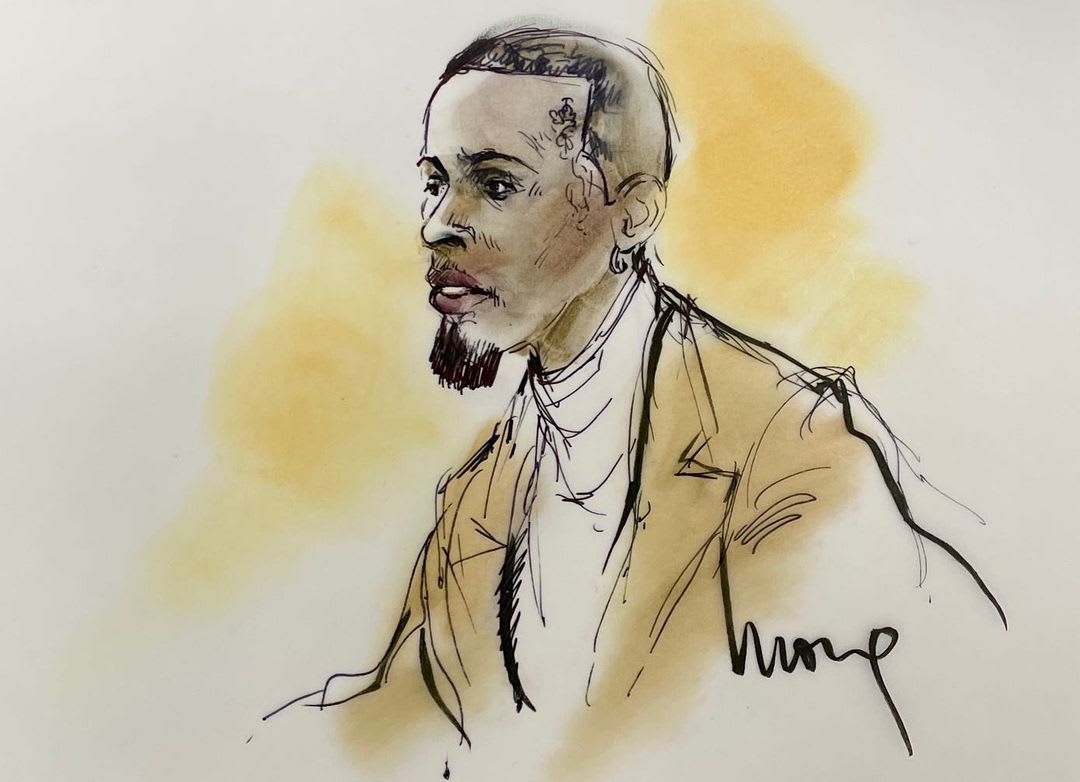
“There were a lot of emotions going on both sides,” she says of the trial. “I was really struck by the two completely different groups who were in that courtroom: the pro Tory, and pro Megan [fans]. It was really crazy. I’m really objective, and I don’t know the players, and I don’t have an opinion. I just draw the pictures. I don’t have a side ever.”
This is far from the last time we’ll be seeing Edwards’ illustrations. Tory Lanez’s sentencing has been delayed to Feb. 28 amid a change in the rapper’s legal counsel. Edwards confirms that she intends to be in court next month.
“I was really struck by the two completely different groups who were in that courtroom: the pro Tory, and pro Megan. It was really crazy. I’m really objective, and I don’t know the players, and I don’t have an opinion.”
In a phone interview from Edwards’ California home, she spoke to Complex about her illustration process, her observations from inside the Tory Lanez trial, the most stunning celebrities she’s witnessed, and more. The interview, lightly edited for clarity, is below.
How do you typically get assigned to trials?
People know how to find me really easily. I get called by TV stations, by news services like The Daily Mail or BACKGRID or Reuters. They know who I am and they know how to find me. So I never go anywhere unless I’ve been called. And I get requests all the time from agencies in France, Germany, and sometimes from Japan. So once somebody wants to find you, it takes two clicks to find you.
How do you determine which moments to capture? During the Megan Thee Stallion v. Tory Lanez case you caught a moment of Megan tearing up while giving her testimony on the stand.
Right. And pointing her finger. That’s always great to have, but sometimes it doesn’t happen. You wait for that aha moment. But I knew that there was a lot of electricity in that case, and a lot of anger and crying. There were a lot of emotions going on both sides. I was really struck by the two completely different groups who were in that courtroom: the pro Tory, and pro Megan. It was really crazy. I’m really objective, and I don’t know the players, and I don’t have an opinion. I just draw the pictures. I don’t have a side ever. What I do is I do many sketches during the day, and then sometimes I’ll leave it, wait for a moment, and then it comes. Or I’ll just do another sketch like when she was pointing out Tory in the courtroom with her finger. She’s got those really long nails, and I thought that was an important thing. And then juxtaposed that with the sketch of Tory looking at her. So it’s like you’ve got this movement without moving pictures, and you go from one to the next and then you’ve got the story.
Fashion is really a cornerstone because in the Megan Thee Stallion case, when she walked in in that purple suit and all eyes were on her. And we all make determinations to what someone is, or how they portray themselves by what they wear. And then the colors and the shoes and everything, that’s what people want to know.
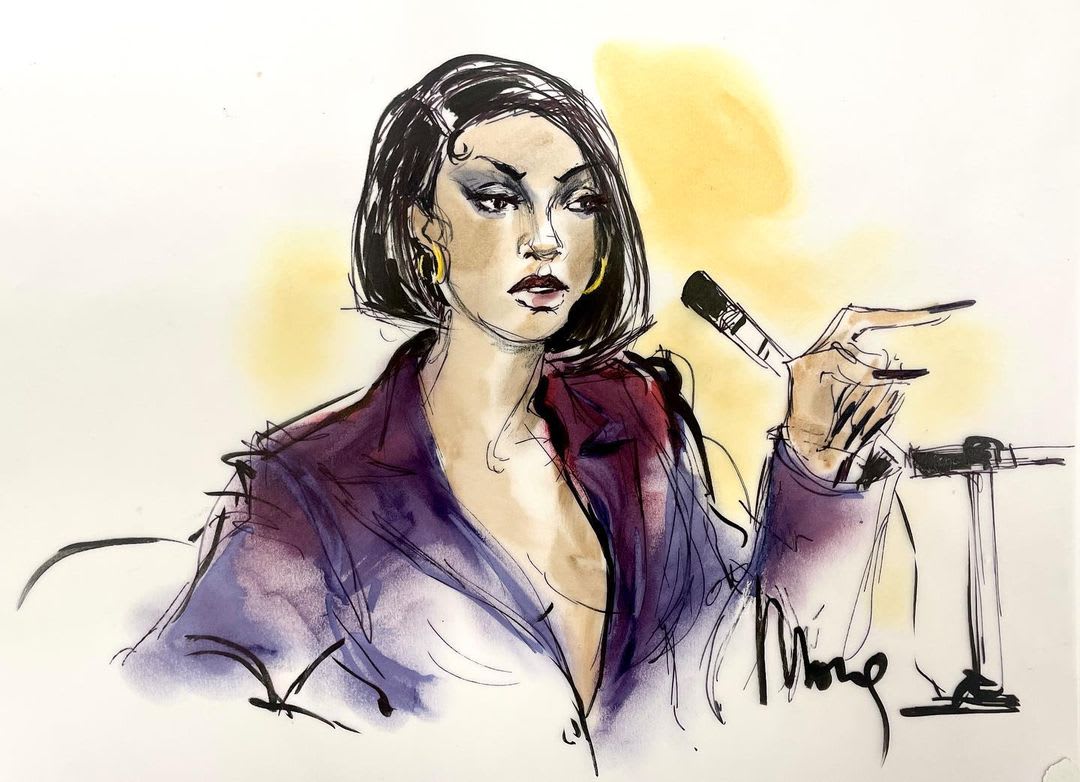
How many illustrations do you typically sketch per trial or day?
When something is in arraignment, it can be three minutes, half a minute, or it can be 20 minutes. Judge says, “Well, how do you plead?” And they say, “Not guilty.” And you’ve got to be ready to get that sketch down and to remember, because that person is then taken out of the courtroom and that’s it. You can’t call and say, “Excuse me, I didn’t get the sketch yet.” So if it’s an arraignment, I’ll do maybe two. When it’s a trial, a trial is all day, and there are numerous witnesses, or maybe there’s one witness that’s on all day. So I try to tell a story with the witnesses. Sometimes witnesses, I can see they’re not that important. So, I don’t bother. I do my own editing, I’m my own art director. Nobody tells me what to draw. I follow along and I say, “OK well, is the TV repairman an important person?” No. But if it’s a driver or the stylist or something like that, yeah, that’s important. So I pick and choose who I’m going to draw, and I will do maybe four or five per day.
“I’ve gotten a lot of commentary, good and bad, but people are very fired up with this case.”
This was a very controversial case, and although you said you didn’t know much about the parties involved or hip-hop in general, how do you resist from having your own opinions or perceptions of the case influence your illustrations?
I divorce myself from following when I’m drawing. I’d be a terrible juror because I do see both sides. I really do. And I can put myself on one side or the other and understand what’s going on. I’ve always done that. I’ve done some trials that are so horrific, that are so horrible. I mean, some of these child torture murder cases are really hard to bear. It’s really hard to stay objective when you see the evidence and you see the pictures, and what they bring in. This one boy was locked in a box and they brought the box in. When it’s a kid’s murder, it’s really hard for me to deal with. But everything else, I draw the pictures and think about both sides, and see both sides to a story.
In addition to drawing the main subject in a case, you also pay attention to the background. In the Megan case, you showed all of the documents and photos on the boards behind her. How does that contribute to the story?
OK, I’ll tell you why I do that. I do that all the time. East Coast artists there are very different from me. You see the sketches that come out from New York and they’re good, but what they’re doing is they’re focusing on the background as far as the architecture, the walls, all of the interior of a courtroom. Who cares? What I want to do is I want to put up all of the evidence that is at that particular moment. And the reason is because one can always remember what happened at that time by looking at the evidence. What I do is I put up charts or I put up photographs while I’m drawing the figures so that I can cement in my mind—in everybody’s mind—what is happening at that time in that courtroom.
There were some really nice comments on your social media posts about your attention to detail.
Oh well, I also got some pretty mean comments, too. Of course I’ve seen some of those where I’ve been on a really tight deadline. There’s one of Tory where I started doing his hair and then I realized the time was running really late and I didn’t finish. I just sort of left it. And I’ve got tons of comments, “Why did [you] draw his hair like that? It’s terrible. “I’m a terrible artist. I should stop drawing.” They said that I was making him bald. I wasn’t making him bald. I just didn’t finish filling in. I mean, if I had filled in, then they would’ve said, “What, are you giving him a toupee?” It wasn’t done on purpose. It’s very weird. I’ve gotten a lot of commentary, good and bad, but people are very fired up with this case.
With the Megan case, there seemed to be a divide between men and women in rap. Did you notice any of that conflict play out in the courtroom?
No, I didn’t notice it as men and women at all. I noticed a lot of women that were on the side of Tory. A lot of them were sitting in back of me and I heard a lot of conversations. And then conversely, I heard a lot of people who were for Megan, so I didn’t put it as a male versus female issue. I was a little bit shocked. Before I go into court, there are so many people lined up to get in, all fans of one or the other. I just listen, but I don’t try to eavesdrop on anyone. But I noticed it was divided, not by sex. That’s only my observation, but I don’t like to get into discussions with people because I don’t want to get involved with what somebody says or their opinions, or asking me my opinions because I don’t have an opinion. I just document.
“I didn’t notice it as men and women at all. I noticed a lot of women that were on the side of Tory.”
I have read stuff about how women don’t have the same control that men do in these things, and that it seems that the hip-hop world is more male-oriented. But where I was, and I had my own seat every day, I’m hearing people behind me talking, it was just so divided just by their comments, not by who was saying it. So when I read that it’s a male-oriented music scene, I didn’t get that because there were so many women who were supporting [Tory].
Many of your illustrations in various cases throughout the years have made celebrities look better than reality…
Don’t ask the Kardashians about that! I think I’m probably one of the most hated people. It was very strange because some of these online news sites were saying that the Kardashians were paying me more towards the end of the trial to [make them] look better. What I see is what I see. I know that the Kardashians do not put out any photographs that are not Photoshopped, and that are not seen by their people before they’re out. What I saw is very different from what you see online. It was shocking. I only draw what I see.
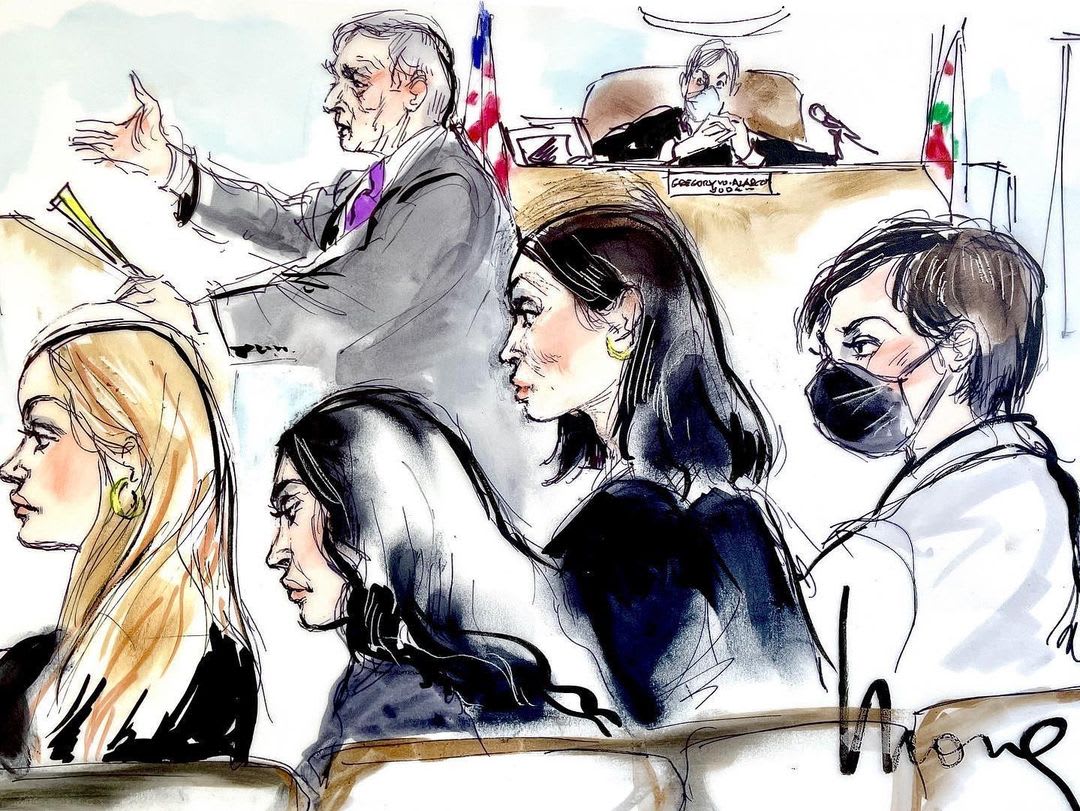
Now, there are certain people who do look much better in real life. Catherine Zeta-Jones, was spectacular and [looked] much better. And then there’s Gwyneth Paltrow who you wouldn’t look twice if you saw her the way that I saw her. She wasn’t made up. She wasn’t on the red carpet. She was crying. Same thing with Paris Hilton. So I think that the idea of somebody looking one way in public and then looking another way online does such a disservice to young people who think that they weigh 100 pounds and that they’re 5’ 5”, 5’ 9” or whatever. They didn’t look like any of that. Their complexions were bad. They were stumpy and short, and the clothes fit badly, and the hair wasn’t beautiful. It’s just so weird. But that’s kind of the nature of it. I think that the internet has really made it very difficult for young women to feel strong. Now I’m thinking of Rihanna. I found her gorgeous, much better than she photographs. I found Halle Berry breathtaking. So there are people, and you go, “Wow. They’re much better looking than they photograph.” And there’s others who aren’t.
The most recent high profile cases, like the Kardashians, Harvey Weinstein, and Megan Thee Stallion, have been void of cameras. All we’ve had is reporters’ retelling of the trial on social media and your illustrations. How do you think your artwork impacts the audience’s perception of the case?
Here’s the thing, people think that if there’s a camera in the case, or you’ve got Court TV or something, you still have editors who are pulling up fragments of a trial. So you’re getting someone else’s idea of what they want to put out. As an illustrator, I guess what I’m putting out is my vision. It can only be my vision. It can only be what I see. I don’t put any emotion into it. Sometimes if I don’t like a person, I still have to draw that person the way that I’m seeing them. And I really try to not put any kind of emotion in it. I’m the storyteller.
“What I see is what I see. I know that the Kardashians do not put out any photographs that are not Photoshopped… What I saw is very different from what you see online. It was shocking.”
Looking back on your artwork from the Megan v. Tory case, what story do you think your illustrations told to the public?
Well, I’ll tell you frankly, what hit me is a cultural thing that I can’t identify with. I’m a white woman from the Westside of Los Angeles. But to think that someone doesn’t want to call the police because they wouldn’t be believed or they would be roughed up because of the color of their skin, they would be treated differently—that really upsets me. To know that that is what goes on is a very upsetting thing to me. I’m getting really upset about that now because that is something I didn’t really think about before. And then I think about this world, that there’s some really different aspects to people’s lives and cultures that we just don’t know. That was a really big thing for me.
What is one of the most bizarre things that you’ve witnessed in the cases you’ve covered?
Oh man, I’ve seen so many bizarre things. Michael Jackson coming in pajamas. Well, they weren’t really pajamas. They were like beach pants with the palm trees. That was bizarre. Somebody fainting, falling on the floor when they’re found guilty. There are just a lot of things like testimony that is just so sickening that it sits with you for months and months. I’m in court and I draw these pictures and I see terrible things, and then I get in my car and I go home. I’ve got my garden. I’ve got my family, I’ve got my animals, I have lots of animals… and then life goes on. So it’s like two different worlds that I live in.
What’s the most important thing people should know about your work as a courtroom illustrator?
I laugh, but I’m really angry because people say, “Well, why isn’t there just a camera? What is that? Why don’t they just take a picture? What is this artist? Why aren’t these drawings more finished and portraits?” People don’t realize that I’ve sometimes got 15 minutes on a sketch. Let them try and do what I’m doing. They do not realize these are not portraits. They’re not paintings. These are done straight and fast. And that’s what they’re supposed to be. They’re not finished pieces of art…. Well, actually, they’re very highly collected. People do buy my stuff. I mean, every case I get requests everywhere for prints and originals. People love courtroom art. It’s quite exciting because it’s of the moment. So I think that people need to realize that courtroom art is a very specific thing. That’s why there’s very few people doing it. There’s a lot of really good illustrators and good artists, but very few courtroom artists.

